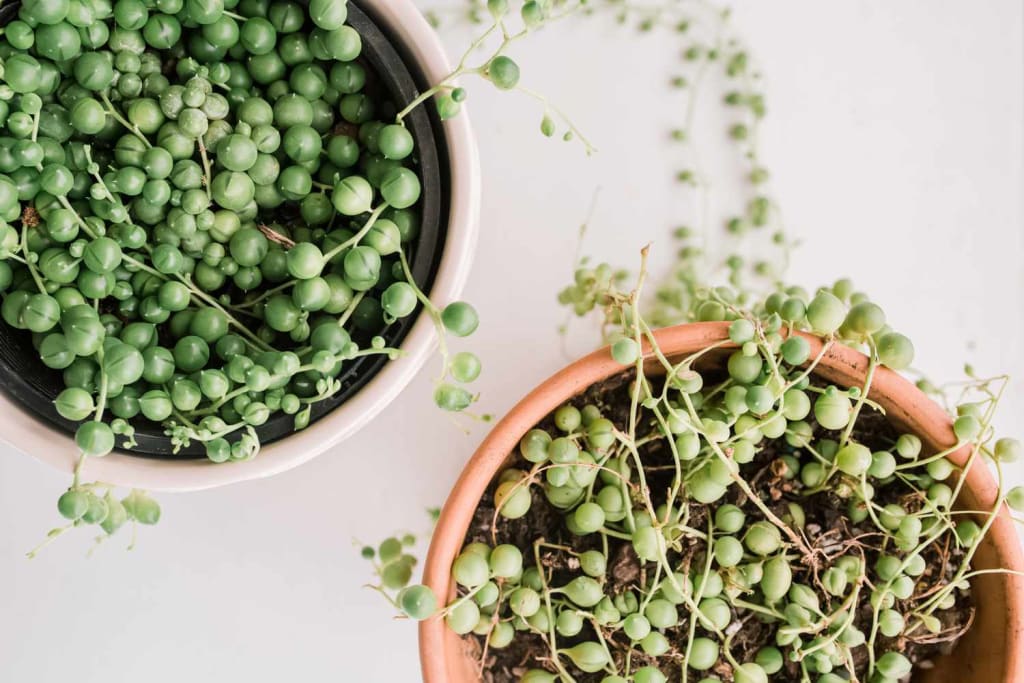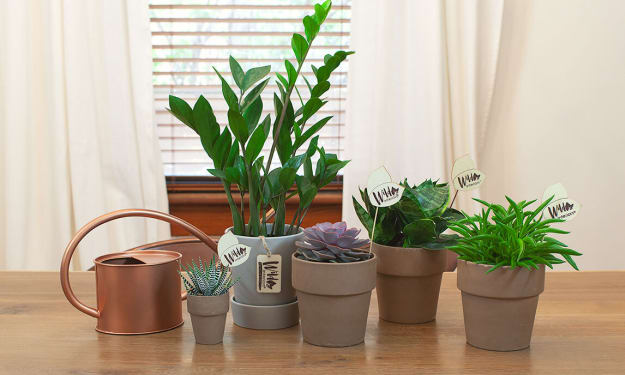The Beauty and Care of String of Pearls Plants
The Beauty and Care of String of Pearls Plants

The Beauty and Care of String of Pearls Plants
String of Pearls (Senecio rowleyanus) is a mesmerizing succulent plant that has gained immense popularity among plant enthusiasts for its unique appearance and relatively low maintenance requirements. With its cascading trails of bead-like leaves, it adds a touch of elegance to any indoor or outdoor space. In this comprehensive guide, we will explore the beauty of String of Pearls plants and provide you with all the care tips you need to help your plant thrive.
Chapter 1: Getting to Know the String of Pearls
1.1 Origin and Background
The String of Pearls plant is native to South Africa, where it can be found in arid regions. It belongs to the Senecio genus, which encompasses a wide variety of succulent plants. The name "String of Pearls" aptly describes its unique appearance, as the plant features long, trailing stems adorned with small, round, bead-like leaves.
1.2 Appearance
String of Pearls is known for its distinctive appearance. The succulent leaves are green and spherical, resembling tiny pearls or peas, which hang down in long, slender trails. This arrangement creates a striking visual effect that makes the plant an ideal choice for hanging baskets or as a trailing plant in decorative containers.
1.3 Varieties
While the classic String of Pearls is the most well-known, there are several other interesting varieties and hybrids available for plant enthusiasts to explore. Some of these include the Variegated String of Pearls, String of Beads, and String of Teardrops. Each variety has its unique charm and appeal.
Chapter 2: The Aesthetic Beauty of String of Pearls
2.1 Decorative Uses
String of Pearls is highly valued for its ornamental value. Its cascading growth habit makes it a perfect choice for hanging pots, containers, or decorative macramé hangers. It can be used to enhance both indoor and outdoor spaces, adding a touch of elegance and greenery to any environment.
2.2 Unique Aesthetics
The plant's spherical leaves, resembling strings of pearls, are a true testament to nature's artistry. When cared for properly, the strands can grow long and lush, creating an enchanting curtain of greenery. This aesthetic appeal makes it a favorite among interior designers and home decor enthusiasts.
2.3 Complementing Various Decor Styles
String of Pearls can complement a wide range of interior decor styles. Whether your space is modern, bohemian, minimalist, or traditional, this plant can be incorporated effortlessly, adding a natural and refreshing element to the ambiance.
Chapter 3: String of Pearls Care Essentials
3.1 Light Requirements
One of the key factors in caring for a String of Pearls plant is providing the right amount of light. These succulents thrive in bright, indirect sunlight. Too much direct sunlight can scorch their delicate leaves, while too little light can result in leggy growth and pale leaves. Finding the perfect balance is essential.
3.2 Soil and Potting
String of Pearls prefer a well-draining succulent mix. You can create a suitable potting mix by combining cactus soil with perlite or pumice to ensure proper drainage. Choose a pot with drainage holes to prevent overwatering and root rot.
3.3 Watering
Succulents are known for their drought tolerance, and String of Pearls is no exception. Allow the soil to dry out completely between waterings. Overwatering can be detrimental to this plant, so it's crucial to err on the side of underwatering. Water sparingly, especially during the dormant winter months.
3.4 Temperature and Humidity
String of Pearls plants thrive in moderate temperatures, ideally between 70°F to 80°F (21°C to 27°C) during the day and slightly cooler temperatures at night. They can tolerate a brief drop in temperature, but it's essential to protect them from frost. Additionally, these succulents prefer low humidity levels, making them suitable for indoor environments.
Chapter 4: Maintaining String of Pearls Health
4.1 Pruning and Trimming
To encourage bushier growth and maintain the plant's aesthetic appeal, occasional pruning and trimming may be necessary. Trim back leggy or overly long stems to promote denser growth, and remove any dead or yellowing leaves to improve the plant's overall health.
4.2 Fertilizing
String of Pearls plants do not require frequent fertilization. During the growing season (spring and summer), you can fertilize with a balanced, diluted, liquid fertilizer every 4-6 weeks. However, it's essential to avoid over-fertilizing, as this can lead to excessive growth and potentially harm the plant.
4.3 Pests and Diseases
While String of Pearls is relatively resistant to pests and diseases, it's still crucial to keep an eye out for common issues such as mealybugs, aphids, and root rot. Regularly inspect your plant for any signs of infestation or disease and take prompt action if necessary. Isolating a diseased plant can prevent the problem from spreading to others in your collection.
Chapter 5: Propagation and Growth
5.1 Propagation Methods
String of Pearls can be propagated through various methods:
Stem Cuttings: Simply cut a healthy stem with at least one node and place it in well-draining soil. Roots will develop from the nodes, eventually giving rise to a new plant.
Division: For mature plants, you can carefully divide the plant at the roots and replant the sections in separate containers.
Offsets: Occasionally, String of Pearls will produce offsets or "baby" plants that can be separated and potted on their own.
5.2 Growth Rate
The growth rate of String of Pearls can vary depending on factors such as light, temperature, and care. Under ideal conditions, they can grow relatively quickly, producing long, cascading strands of pearls. Regular maintenance, such as pruning, can help control the growth and create a fuller appearance.
Chapter 6: Troubleshooting Common Issues
6.1 Leggy Growth
If your String of Pearls is growing long and leggy with widely spaced leaves, it may be due to insufficient light. Move the plant to a brighter location to encourage more compact growth.
6.2 Yellowing or Dropping Leaves
Yellowing or dropping leaves can be a sign of overwatering or poor drainage. Ensure that the soil dries out completely between waterings and that your pot has proper drainage.
6.3 Pest Infestations
If you notice pests like mealybugs or aphids on your plant, remove them gently with a cotton swab soaked in rubbing alcohol. Isolate the affected plant to prevent the infestation from spreading.
6.4 Root Rot
Root rot is a common issue caused by overwatering and poor drainage. If you suspect root rot, remove the affected parts of the plant and repot it in fresh, well-draining soil.
Chapter 7: Creative Display Ideas
7.1 Hanging Planters
String of Pearls is a natural choice for hanging planters. The cascading stems create a stunning visual effect when allowed to drape down, making them perfect for display in decorative macramé hangers.
7.2 Terrariums
You can also create beautiful terrariums using String of Pearls. Combine them with other small succulents and decorative stones to craft a miniature desert landscape.
7.3 Mixed Container Gardens
Planting String of Pearls alongside other succulents in a large container garden can create a captivating focal point in your outdoor space.
Chapter 8: String of Pearls in Different Environments
8.1 Indoor Spaces
String of Pearls can thrive indoors, provided they receive adequate light. They are an excellent choice for enhancing the decor of living rooms, bedrooms, kitchens, or offices. Their unique appearance adds a touch of nature to any indoor environment.
8.2 Outdoor Gardens
In regions with a mild climate, String of Pearls can be grown outdoors in gardens or on patios. They make lovely ground cover or can be used in hanging baskets to create a cascading effect.
8.3 Xeriscaping
For those in arid climates, String of Pearls is an excellent choice for xeriscaping, as they require minimal water and can thrive in dry, desert-like conditions.
Chapter 9: Conclusion
In conclusion, the String of Pearls plant is a stunning and captivating addition to any plant collection. Its unique appearance and relatively low maintenance requirements make it a favorite among plant enthusiasts. By providing the right care and attention, you can enjoy the beauty of String of Pearls for years to come, whether indoors or outdoors, in hanging baskets or terrariums. So, go ahead and bring a touch of natural elegance into your space with this remarkable succulent. Happy gardening!
About the Creator
Kavya Organic Garden
Passionate about home gardening, plant care, growth, and maintenance. Join me on this exciting journey of organic practices and sustainable gardening! 🌱






Comments
Kavya Organic Garden is not accepting comments at the moment
Want to show your support? Send them a one-off tip.